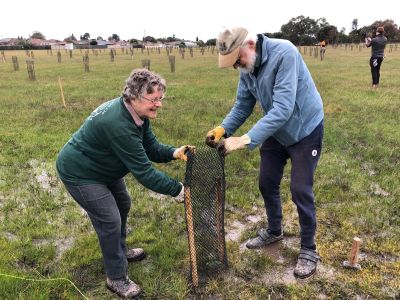On a crisp June morning, a committed group of community volunteers knelt in the soil along Merri Creek, trowels in hand, planting shrubs that will shape the future of their neighbourhood. Among the 12,000 seedlings funded through the MCMC Green Links project were a handful from Euroa, 150 km to the north – plants that had never felt Melbourne’s chilly winter before yet might hold the key to thriving here as the climate changes.
 Volunteers planting the Tree Banksia Orchard in Fawkner.
Volunteers planting the Tree Banksia Orchard in Fawkner.
“The half dozen shrub species we got from Euroa Arboretum are very common species that have been planted by the thousands along Merri Creek over the years, but the idea was to source a small amount from non-local populations,” explains Michael Longmore, Ecological Restoration Program Manager at MCMC. “They’ve been descended from plants adapted to a warmer, drier climate, analogous to the climate that Melbourne will face in future.”
This small-scale trial included around 250 plants – Gold Dust Wattle, Hedge Wattle, Sweet Bursaria, Rock Correa, and Tree Violet – spread across several sites in Northcote. “We aren’t intending to do any specific monitoring this time round,” Michael says. “It’s very much an exploratory step, to start thinking about how climate adaptation might play a role in future plantings.”
According to the Victorian Government’s Department of Energy, Environment and Climate Action (DEECA), by 2030, annual average temperatures in Australia are predicted to rise by 0.6–1.3°C. While changes will vary across the continent, Victoria’s overall climate is expected to get hotter and drier. To help address this, DEECA recommends that up to 20% of plants in revegetation projects be sourced from warmer, drier climates to build resilience.
While this year’s Euroa-sourced plantings constitute a small, preliminary step toward the recommended 20%, another MCMC project is already taking a more climate-adapted approach.
MCMC’s Tree Banksia Orchard in Fawkner was established in 2022 with the support of the Merri Creek Environment Fund, the Friends of the Forgotten Woodlands, and numerous local volunteers. The orchard brings together genetic material from 11 Silver Banksia (Banksia marginata) populations across the Victorian Volcanic Plains, along with three populations from areas that resemble Melbourne’s projected future climate.
“The orchard is designed to provide a convenient source of genetically diverse, climate-adapted seed,” Michael explains. “We track each plant, so if one dies, we can replace it with one of the same origin. Over time, this will help us repopulate the volcanic plains around Melbourne with Tree Banksias once again.”
Silver Banksia woodlands were once a keystone of the Merri catchment and broader Victorian Volcanic Plains, providing winter nectar for honeyeaters and migrating birds. While remnant populations in the Merri catchment are now extinct, the orchard combines historical records, ecological research, and careful volunteer planting to bring these forgotten woodlands back.
“Some climatic changes are already evident along the Merri Creek,” Michael notes. “Certain species that would naturally occur in drier areas northwest of Melbourne are now thriving here. Climate adaptation is something we’ll have to think about more and more and incorporate into our work in a thoughtful and considered way.”
By blending local plantings with carefully sourced climate-adapted species, MCMC is taking early, cautious steps to explore how Melbourne’s landscapes might withstand hotter, drier conditions. The Euroa plantings and the Banksia Orchard are just the beginning – modest experiments that will guide bigger decisions in the years to come, as MCMC continues to ask the central question: how can we give native species along Merri Creek the best chance to thrive in a changing climate?





 Merri Creek Management Committee. 2 Lee St, East Brunswick, Victoria, Australia 3057
Merri Creek Management Committee. 2 Lee St, East Brunswick, Victoria, Australia 3057